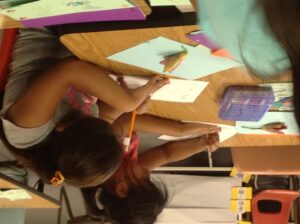What’s the Reason for a Flower?

Author(s): Stacey David
Subject: Life Science
Grade Level(s): Grade 3
Big Idea(s): Plants have different structures and adaptation that help them survive, meet their needs, grow, and reproduce.
What you need: The Reason for a Flower by Ruth Heller
Pencils
Flowers
Colored Pencils
Plates
Hand Lens
Tweezers
Science Journals
Flower Drawing Worksheet
Flower Assessment Worksheet
Setting: This is a whole class activity in a classroom. Students dissect flowers independently and pair-share with a partner for the reflection and wrap up.
Time Needed: 45 minutes
Summary:
In this lesson students will learn the structure of a flower by dissecting, drawing, and labeling flower parts.
Learning Goals / Objectives:
Objective: Students will learn the structure of the flower parts.
Standards: 3a. Students know plants and animals have structures that serve different functions in growth, survival, and reproduction.
Enduring Understanding: What is the job/function of each part of the flower?
Background
To save time during the lesson read the story The Reason for a Flower by Ruth Heller before hand.
Students generated a placemat consensus map with adjectives to describe how a flower looks in their head. (See attachment for placemat consensus map directions)
Students wrote: My flower is __________ (adjective) because ______________________.
Students did a picture sort and classified pictures of flowers based on how the flowers looked.
Student wrote comparative sentences about flowers: The _________(flower name) is __________er (adjective) than __________________(flower name) because __________.
Setup:
Materials can be pre-prepped by placing tweezers, hand lenses, and flowers on plates. Photo copies of the worksheets should be made.
Anticipatory Set:
Review the activities that where completed during the week (see background information).
Review story facts.
Tell students, “Each flower seems to be unique, with its own special beauty. But all flowers are composed of the same parts. You and your friends are all unique, but you all have the same parts too: eyes, ears, noses, fingers, and so on. The difference is that different types of flowers have different numbers of these parts; for example, one type of flower might have four petals while another type has five.”
Ask Students: What are some flower parts you already know? roots, stem, petals, seeds, and flower.
Ask Students: Where did you learn about those parts? Second grade, other books, prior knowledge
Instructions / Activities:
Part I:
In your own way have students get the flowers, plates, hand lens (group leaders, teacher passes out, etc.)
Have students look carefully at their flower and spend some time drawing a colored picture of it on their flower drawing worksheet. (4-5 minutes)
Have students pair share their picture and give feedback to each other.
Write feedback sentence on board and model. I like your picture because ___________________. I wonder __________________ about your picture?
Part II:
I Do:
Model how to dissect the flower using the hand lens and the tweezers. Stress to students to use the tools carefully because the flowers are fragile. Only dissect one part of the flower so you do not give it all away.
We Do:
Verbally ask students the steps they might take to dissect their flower.
You Do:
Ask the students to dissect their flowers gently and draw each part on the second half of the flower drawing worksheet.
Part III:
This is more of a direct instruction:
Guide students to examine the pictures of their dissected flower. Together as a class (teacher does one in front of the class and students use their pictures) label the sepals, leaves, petals, pistil, and stamens on the flower drawing worksheet.
Questions:
What part of the flower do you predict will become the fruit and seeds?
How does the pollen get to the pistil?
List things that would change if there were no more flowers?
Assessment:
Students complete the Flower Assessment Worksheet where they will need to match the flower vocabulary with the picture description.
Wrap-up / Closure:
Think-Write-Pair-Share in science journal: What is your favorite part of the flower? Why?
Tags: Grade 3
Categories: Life Science

